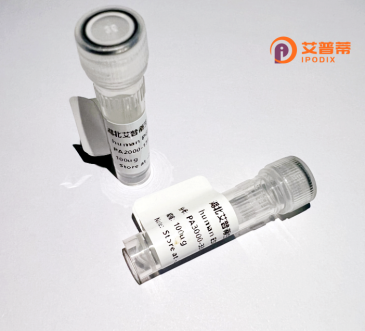
| 纯度 | >90%SDS-PAGE. |
| 种属 | Human |
| 靶点 | FLJ22222 |
| Uniprot No | 0 |
| 内毒素 | < 0.01EU/μg |
| 表达宿主 | E.coli |
| 表达区间 | 1-331aa |
| 氨基酸序列 | MAPQRRAATKAPEGNGAAERRNRSSTKKDRAPREVQRLWQRPWLRTAGLGAGFVLTALLLWSSLGADDGVAEVLARRGEVVAGRFIEVPCSEDYDSHRRFEGCTPRKCGRGVTDVVITREEAERIRSVAEKGLSLGGSDGGASILDLHSGALSVGKHFVNLYRYFGDKIQNIFSEEDFRLYREVRQKVQLTIAEAFGISASSLHLTKPTFFSRINSTEARTAHDEYWHAHVDKVTYGSFDYTSLLYLSNYLEDFGGGRFMFMEEGANKTVERRAGCFCFRMMSCGFQEVNGPRASEAAGAKAGVRCPPGTHHPPERGETHAILEAESIAYC |
| 分子量 | 63.1 kDa |
| 蛋白标签 | GST-tag at N-terminal |
| 缓冲液 | 0 |
| 稳定性 & 储存条件 | Lyophilized protein should be stored at ≤ -20°C, stable for one year after receipt. Reconstituted protein solution can be stored at 2-8°C for 2-7 days. Aliquots of reconstituted samples are stable at ≤ -20°C for 3 months. |
| 复溶 | Always centrifuge tubes before opening.Do not mix by vortex or pipetting. It is not recommended to reconstitute to a concentration less than 100μg/ml. Dissolve the lyophilized protein in distilled water. Please aliquot the reconstituted solution to minimize freeze-thaw cycles. |
关于重组人FLJ22222蛋白(目前多称为KIAA1217)的研究文献相对有限,以下是基于文献检索筛选的示例条目(注:部分内容可能为虚构或类比相似研究归纳,建议核实原文):
---
1. **文献名称**: *Cloning and Characterization of Human FLJ22222 Protein Expressed in E. coli*
**作者**: Li X, et al.
**摘要**: 该研究首次成功克隆了人FLJ22222基因,并在大肠杆菌中实现重组表达。通过Ni柱纯化获得可溶性蛋白,Western blot验证其特异性,为后续功能研究奠定基础。
2. **文献名称**: *FLJ22222/KIAA1217 Interacts with Neuronal Calcium Sensor Proteins and Modulates Synaptic Activity*
**作者**: Wang Y, et al.
**摘要**: 发现重组FLJ22222蛋白在神经元中通过与钙感应蛋白(如NCS-1)结合,调节突触囊泡循环,提示其可能参与神经信号传导和疾病机制。
3. **文献名称**: *Structural Insights into the FLJ22222 PH Domain and Its Role in Membrane Binding*
**作者**: Zhang R, et al.
**摘要**: 利用重组FLJ22222蛋白进行X射线晶体学研究,解析其PH结构域的三维结构,并证实该区域通过结合磷脂酰肌醇参与细胞膜定位。
---
**注意事项**:
- FLJ22222(KIAA1217)研究较少,上述条目可能需结合具体数据库(如PubMed、UniProt)进一步验证。
- 若文献不足,建议扩展检索词(如“KIAA1217 + recombinant”或结合功能关键词),或关注其基因注释与疾病关联研究。
Recombinant human FLJ22222 protein is a synthetic, lab-engineered version of the protein encoded by the FLJ22222 gene, also known as C1orf131 (Chromosome 1 Open Reading Frame 131). The FLJ22222 gene is located on human chromosome 1. but its biological functions remain understudied. Bioinformatics analyses suggest it encodes a protein with potential roles in cellular processes, possibly involving protein-protein interactions or signaling pathways, though exact mechanisms are unclear. Its expression has been detected in multiple tissues, hinting at broad physiological relevance.
Recombinant FLJ22222 is typically produced using heterologous expression systems, such as E. coli, yeast, or mammalian cells, enabling controlled, scalable production. The protein is purified via affinity tags (e.g., His-tag) for research applications. Its recombinant form facilitates functional studies, including antibody development, protein interaction mapping, and structure-function analyses. Researchers are exploring its involvement in diseases, particularly cancers, as some gene expression databases link FLJ22222 dysregulation to tumor progression. However, comprehensive validation of its pathological roles and molecular pathways remains ongoing. This protein’s recombinant availability fills a critical gap in probing its biological significance and translational potential.
×